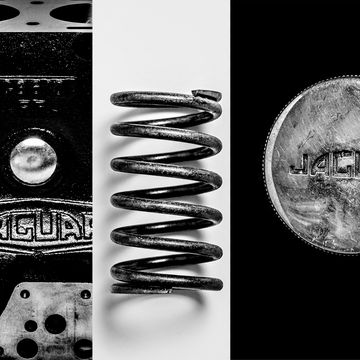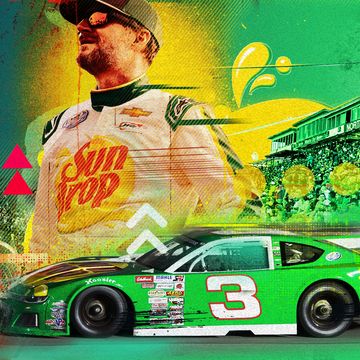When people talk about the Ferrari F355, they talk about it for two reasons. If you’ve spent any time on the internet, you’ll know the mid-engine Nineties supercar is known for its exuberant maintenance costs. You’ll also know the F355 has, arguably, the best-sounding road-going V-8 ever produced. What few mention is just how delightful the F355 can be to drive.
To drive an F355 is to have a perfect supercar experience. Especially one as flawless as this 1997 Blu Le Mans example, which was provided and sold by The Cultivated Collector, and owned by ThePetrolBarn. A few hours behind the wheel and a handful of twisty roads resulted in automotive nirvana of the highest degree. It’s the perfect mix of vintage, analog feedback and modern technological niceties, all packaged into a handsome design that only gets better the longer you stare at it.
As far as mid-engine supercars go, the F355’s cabin is about as good as it gets. There’s a surprising amount of space and a sense of airiness thanks to the plentiful glass, which also delivers a refreshing amount of outward visibility. Every control is easy to reach, and you don’t need to contort yourself to get in and out of the comfy leather-clad driver’s seat.
It’s here where you realize just how livable the F355 can be. The steering is full of feel, but not overly heavy. There’s working air conditioning. There are even two-mode adjustable shocks—something we take for granted in modern sports cars, available all the way back in 1997. The six-speed gearbox, a magnificent, long-necked, gated affair, responds well to quick, decisive shifts, though it can be resistant if you’re hesitant with your wrist movements.
On the road, the F355 is essentially faultless. The seating position is perfect, and the steering is among the best I’ve ever felt in a road car. It’s not as lightning quick as a current Ferrari, but the thin-rimmed wheel is light and tells you exactly where the wheels are pointing. The clutch is as easy to modulate as any new car, and the suspension feels controlled and modern. Best of all, a working climate control means you don’t melt after a few minutes in the sun. It’s an overwhelmingly pleasant experience, whether you’re cruising or really on it.
The same can be said for the engine, at least in one aspect. The 3.5-liter F129B V-8 can be excused for all of its reliability-based faults solely because of the sound it makes. The F355’s exhaust noise is well-documented online, but hearing it from the inside is a different experience entirely. The flat-plane motor sounds far more guttural from within the cabin, almost as if the exhaust has been tuned to deliver a sound one octave lower. At lower rpm the engine feels almost upset, as if it’s angry at you for not using its full potential. Sure, you can putter around town under 3000 revs, but the entire drivetrain is far more content when it’s being pushed to redline.
It isn’t all theater, either. The 40-valve power plant made 375 hp and 268 lb-ft of torque when new, enough to make the F355 feel legitimately quick even today. Our colleagues at Car and Driver were able to squeeze out a 0-60 time of just 4.5 seconds back in 1995. I have no doubt it could keep up with new cars like the Supra and Nissan Z on a set of twisty back roads, especially because it’s just so easy to drive.
Spending any amount of time behind the wheel of an F355 invites dangerous notions. “Wow, I’d love to own one of these,” you may think. Unless your bank account is stuffed with money you’d happily part with again and again, I’d advise against that. Ferrari recommends an engine-out timing belt service every three years that, withholding any other problem points the tech finds, will run you between $7000-$10,000. And rest assured, other problems will be found.
In addition to the timing belt’s tendency to expire and fail, the F129B’s bronze valve guides also need to be replaced to avoid catastrophic damage. Then there are the exhaust manifolds, which are known to crack, and the catalytic converters, which can clog and fail. The actuators on top of those adjustable shocks I mentioned earlier can go bad, and the rear tires typically only last around 7000 miles. It’s recommended to get them replaced at a Ferrari dealership, as the expensive magnesium wheels are easily damaged by normal tire-changing machines. A clutch job will run you anywhere from $3600-$4000, while a simple oil change costs $500. Expect every dealership visit to swing into the five-figure range.
The Ferrari F355 is, then, the perfect one-time supercar experience. The ultimate car for borrowing, for trying out. It checks all the boxes: Exotic looks, wild sounds, exceptional handling, gated manual transmission. Everything you could dream of feeling while behind the wheel of a Ferrari. But far more than any similarly priced exotic is the price to remain in the club. We suggest bumming a ride from a wealthy friend instead of buying one, unless you want to spend a good portion of the car’s value on maintenance every few years. Such is the price of experiencing perfection.

Brian Silvestro is Hearst Autos' Lead Deputy Editor for rankings content. He spent over seven years as a staff writer for Road & Track Magazine, and still contributes regularly with car reviews, industry interviews, and more.
He also has a taste for high-mileage, rusted-out projects and amateur endurance racing.








